Frost-resistant high-yielding pear variety “Cathedral”
The early-growing, mid-year variety of Cathedral pear pleases gardeners with fragrant, regularly shaped fruits. Their pulp is sweet, oily, fine-grained, contains 8.5% sugar and only 0.3% acid. Pears do not have a shelf life and are suitable for fresh consumption and the preparation of dried fruits, jam, compotes and marmalade. In this article we have collected complete information about the Cathedral pear variety: description, characteristics, ripening time, planting features and care details.
History of origin and description of the Cathedral pear variety
Pear Cathedral is a mid-year variety bred by engineers of the Moscow Agricultural Academy named after. K. A. Timiryazeva" by crossing the Forest Beauty variety with a hybrid of the same Forest Beauty and Duchess.
Originators: S. T. Chizhov and S. P. Potapov. State tests began in 1990, and in 2001 the variety was included in the State Register of the Russian Federation. The pear received permission to be grown in the Central region.
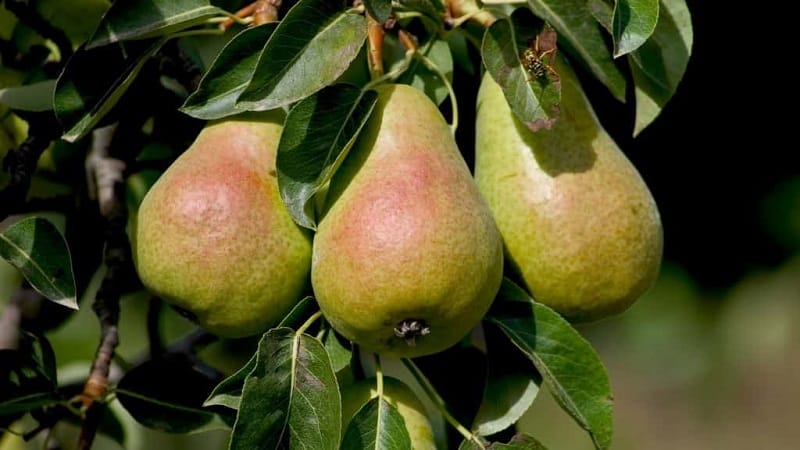
Characteristics of the variety
The table shows the distinctive characteristics of the variety:
| Indicators | Characteristics |
| Tree | Medium height, 3-5 m high. The crown has a regular conical shape. The branches are straight, sparsely spaced, the ends point upward. |
| Escapes | Straight, round, red-brown, with slight pubescence. The buds are wide-conical, large in size, pubescent. |
| Leaves | Medium to large size, green in color, oval in shape, slightly pointed, smooth, glossy.The leaf blade is concave, curved upward, with small serrations along the edge. |
| Beginning and type of fruiting | The first fruits appear 3-4 years after planting. Fruits on simple ringlets and annual shoots. |
| Fruit ripening | Second ten days of August. |
| Bloom | In April - May. The flowers are large, cup-shaped, white, oval petals. |
| peduncle | Medium, curved |
| Fruit shape | Regular, pear-shaped, lumpy surface. |
| Seed chambers | Closed type, small. The subcupal tube is long and funnel-shaped. The seeds are small and medium-sized, ovoid, dark brown in color. |
| Pulp | White, tender, juicy, medium density, fine-grained. |
| Skin | Smooth, thin, oily, glossy. The color is green-yellow at the moment of removable ripeness, light yellow in the consumer state. The cover color is weak, blurred, in the form of a red blush. There are many subcutaneous points, but they are almost invisible, gray or green in color. |
| Weight | 110-120 g |
| Taste | Sweet and sour. 4 points on a five-point scale. |
| Sugar, % | 8,5 |
| Acid,% | 0,3 |
| Dry substances, % | 16 |
| Aroma | Average |
| Purpose | Table food - for fresh consumption, processing into jam, dried fruits, marshmallows and compotes. |
| Productivity | 85 c/ha, maximum rate - 136 kg/sq. m. From one tree - 35-40 kg. |
| Marketability, % | 95 |
| Keeping quality | 10-12 days |
| Transportation | Average |
| Sustainability | To severe frosts (up to -30°C), scab, sooty fungus. |
Pollinators
The Cathedral pear is self-fertile, sets fruit well without “helpers”. However, gardeners recommend planting it next to suitable pollinating varieties to increase the yield and quality of the fruit. The varieties Lada, Chizhovskaya, Rogneda and Detskaya are ideal for this pear.

Advantages and disadvantages
Advantages of the variety:
- winter hardiness;
- immunity to scab;
- precociousness;
- pleasant taste and aroma;
- juicy pulp;
- stable fruiting;
- high yield.
Flaws:
- small and medium sized fruits;
- short shelf life;
- low level of transportability.
Planting seedlings
Planting of seedlings is carried out in spring and autumn. In regions with warm climates, autumn planting is practiced - in late September - early October. This type of planting has an undeniable advantage: a sufficient amount of moisture collects in the soil, which stimulates root formation and increases the survival rate of seedlings.
Trees planted in autumn tolerate changes in air temperature well and are resistant to insects and diseases.
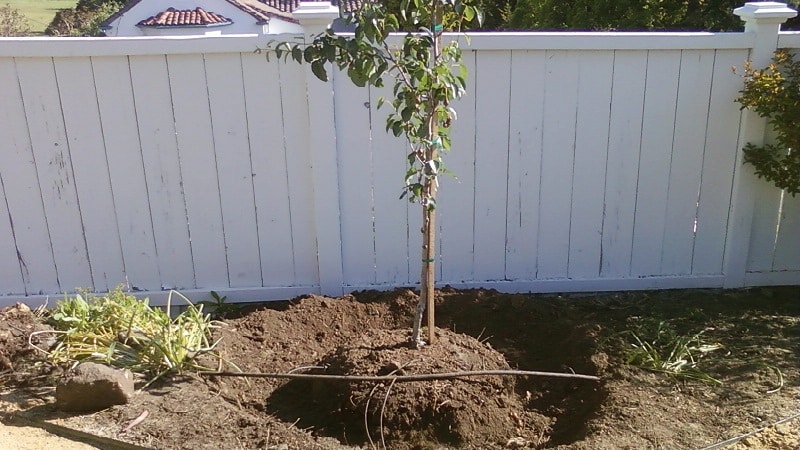
In the central regions of Russia, spring planting is carried out - late April - early May. The root system has time to take root in the new location before the first frost, which ensures a successful winter for the seedlings.
Reference. It is recommended to plant the Cathedral pear variety immediately in a permanent place, since the plant does not tolerate transplants.
The crop is demanding on soil composition and grows and develops best on breathable, nutritious sandy loam chernozem. You should avoid areas with high groundwater levels - accumulated water freezes in winter and harms the plant. If there is no other way out, the seedlings are planted on an artificially created hill.
Pear loves warmth and sunlight, so it feels best in the southern part of the garden. When there is a lack of lighting, the branches stretch towards the light and often break under the weight of the fruits and their own weight. Therefore, for this crop it is preferable to plant in spacious areas without shading, but with protection from drafts.
The optimal age of high-quality planting material is 2-3 years. There should be no damage on the branches. The bark is smooth and elastic. The rhizome is developed, without flaws, with a large number of root shoots.
About other pear varieties:
Landing instructions:
- The pit is prepared in advance. For planned spring planting, it is dug up in September - early October, for autumn planting - two weeks before the target date.
- Pit diameter and depth depend on the development of the rhizome. Standard dimensions: diameter - 0.8 m, depth - 1 m.
- The top layer of soil is discarded to the side when digging, and then mixed with 20 liters of humus, 20 liters of peat and 10 liters of coarse sand.
- The soil is mixed with 3 tbsp. l. potassium sulfate and 200 g of superphosphate and pour to the bottom. Soil fertilized with organic matter is poured on top and 20 liters of water are poured.
- Two weeks after watering the hole start landing. They retreat 30 cm from the center of the hole and dig in a support for the seedling so that after planting it protrudes 0.5 m above the ground.
- Earth is collected around the support in the form of a hill.
- The leaves of the seedling are cut off and remove damaged roots.
- The rhizome is dipped into the “Heteroauxin” solution for 20-30 minutes, then placed on a hill. The roots are carefully distributed and covered with the remaining nutrient soil. The root collar should remain 5-7 cm above the soil. The soil is watered for better shrinkage.
After planting, the seedling is tied to the support with soft ropeswithout crushing the bark, and shake it periodically so that the earth fills the voids between the roots. A shaft with a diameter of 0.3 m is formed around the tree so that the water does not spread when watering.

Subtleties of care
The agricultural technology of the Cathedral pear variety is standard and provides for moderate watering, whitewashing, fertilizing if necessary, prevention of fungal diseases.
Watering intensity
Mature trees can withstand drought and do not need additional watering., but young trees are watered regularly. Water consumption per pear is 20-30 liters. Watering frequency: once a week in two approaches, morning and evening. Water is poured in carefully so as not to wash away the soil around the roots. The ideal way to water a pear is by sprinkling.
During the fruiting period, watering is increased more frequently to preserve the harvest.. After harvesting the fruits, watering is stopped. The exception is drought at the end of August.
After each watering, loosen the soilto prevent the appearance of a dense earthen crust, which prevents air from penetrating to the rhizome.
Advice. Mulch the tree trunk circle with straw, peat or sawdust. Mulch retains moisture in the soil and stops the growth of weeds.
Soil fertilization
The frequency of fertilizing depends on the fertility of the soil and the appearance of the tree.. Pears planted on well-fertilized soil grow faster and produce a rich harvest. They do not need to be fed annually. Poor sandy soil is fertilized with organic matter and minerals every year, after the snow melts, in summer and autumn.
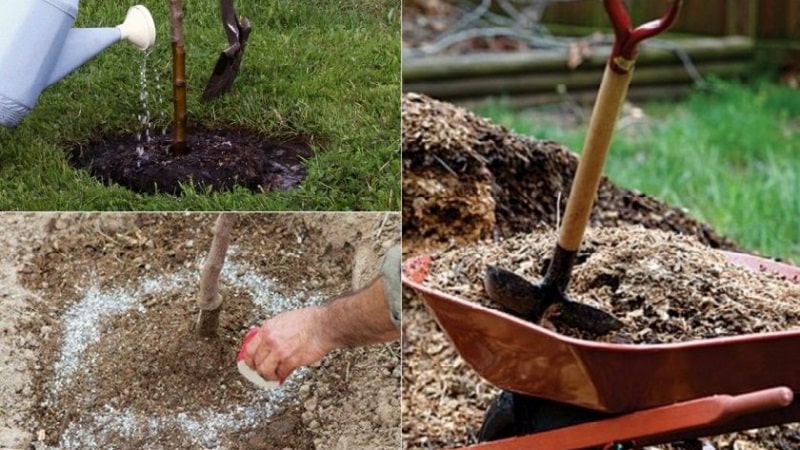
The table shows the schedule for applying fertilizers seasonally:
| Season | Fertilizer and dosage | Purpose |
| Spring | Before flowering:
After flowering: chicken manure infusion 1:15. Consumption - 25 liters per tree after watering. |
Acceleration growth of foliage and shoots, formation of a healthy ovary. |
| Summer | In mid-June: chicken manure infusion 1:15.Consumption - 25 liters per tree after watering.
Mineral fertilizers for digging:
|
Strengthening immunity, accelerating fruiting. |
| Autumn | Potassium phosphate fertilizers:
|
Preparing for winter. |
Trimming
Pruning is done before sap flow begins - in April.
The branches of a young tree are pruned with pruning shears, starting from the second year of development, following the rules:
- Healthy branches are left, weak ones are removed.
- The branches are cut into rings, leaving no stumps.
- No more than 14-15 branches are cut in one approach.
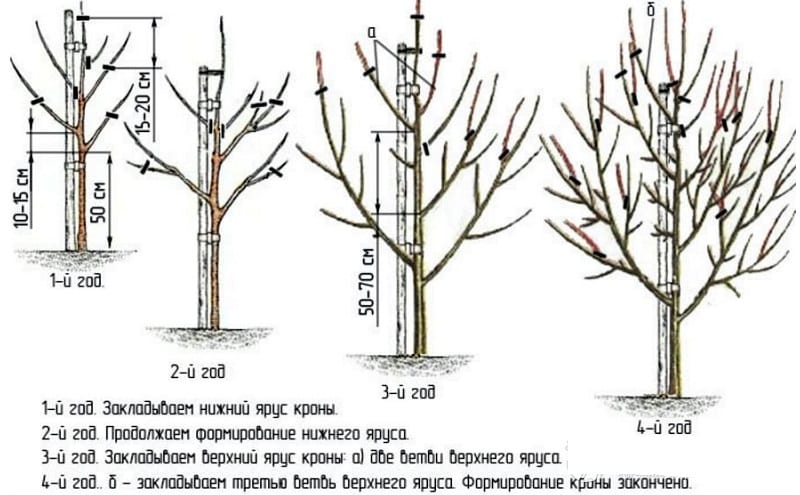
Sanitary pruning of mature trees is carried out every year.: cut off dry branches and thin out the crown, remove weak shoots and tops.
Advice. In the first year of flowering, remove 80% of the flowers from the seedling. This procedure preserves the strength of the tree and contributes to its better development in the future.
Wintering
For successful wintering, the tree is watered abundantly before the first frost.so that the root system has time to absorb moisture. Then the tree trunk circle is mulched with straw or sawdust in a layer of 25-30 cm.
Mature trees successfully winter without shelter, but seedlings and young trees 2-3 years old can freeze in severe frost. Therefore, at the end of October - beginning of November, the trunks are wrapped in cardboard or spruce branches. The branches are tied with rope and covered with an awning or dense agrofibre. This will protect them from wind damage.
Whitewash
Whitewashing with slaked lime protects the bark from the bright spring sun and insects. 1 kg of clay and 2 kg of lime are dissolved in 10 liters of water.The composition is applied to the trunk, moving from the ground to the lower branches.
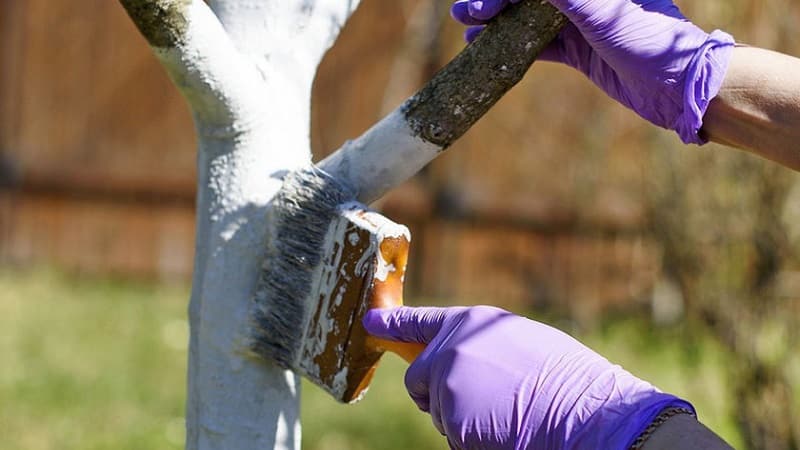
Disease and pest control
Pear Cathedral is not afraid of scab and sooty fungus; with proper care, it rarely suffers from fungal diseases. Without proper care, trees weaken and become susceptible to fungi.
The table shows the main pear diseases and treatment tactics:
| Disease | Signs | Treatment | Prevention |
| Rust | Leaves with orange spots dry out and fall off. | Before and after flowering - 1% solution of Bordeaux mixture.
“Skor” (2 ml per 10 liters of water) - when foliage appears, during the flowering period and after. |
Cleaning and burning dry leaves, digging up the tree trunk and adding copper sulfate. |
| Fruit rot (moniliosis) |
Brown spots on fruits and growths with fungal spores inside. The pulp of the fruit is loose and unpleasant to the taste. | Treating wood with 1% Bordeaux mixture, “HOM” in spring and autumn.
Whitewashing with lime mortar: 1 kg of powder per 10 liters. |
Timely removal of dry and diseased branches and infected fruits. |
| Stem rot (cystoporosis) | Dark red bark, a large number of dry branches. | Treatment with a 3% solution of Bordeaux mixture, “Nitrophen” (300 g per 10 l) until the buds swell.
During the budding period - a solution of copper oxychloride (900 g per 10 l). Consumption - 3 liters per 1 tree. After flowering - 1% solution of Bordeaux mixture. Twice with an interval of two weeks. |
Removing the affected bark, treating wounds with copper sulfate and garden pitch.
Autumn whitewashing of the trunk and skeletal branches. |
| Powdery mildew | White coating on shoots and foliage, deformation and falling of flower ovaries. | Before budding and after flowering, spray trees with a solution of “Fundazol” or “Sulfite”. | Cleaning and burning fallen leaves. |
Read also:
Review of the pear variety Autumn Yakovleva
A selection of the best varieties of winter-hardy pears for Siberia
The table describes the main pear pests and methods of controlling them.:
| Pest | Signs | Struggle | Prevention |
| Green aphid apple |
Curling of foliage and drying out of the upper shoots. | Double treatment of trees in early spring and summer with Nitrofen, Karbofos, Kemifos, Decis, Cyanox.
|
Whitewashing and removal of old bark, deep digging of the trunk circle, removal of weeds. |
| leaf roller | Leaves twisted into a tube and covered with cobwebs. | Before budding - “Detox”, “Zolon”, “Tagore” (10 ml per 10 liters of water). Consumption - 2-5 liters per tree, taking into account age. | Removing affected leaves and clutches of the pest from the bark. |
| Gall mite | The pest feeds on bark sap, the tree dries, the leaves wither and fall off. | Double treatment (spring and summer) with Fufanon, a solution of colloidal sulfur (5-10 g per 10 liters of water).
|
Removal of affected areas. |
| Pear slowpoke |
The pest's food source is intercellular sap. Buds and leaves shrink and fall off. | Before the leaves appear - “Nitrophen” (200 g per 10 liters of water).
|
Autumn digging of soil in the tree trunk circle, removal of old bark and diseased branches. |
Harvest and storage
Cathedral pear is a fast-growing variety. The first harvest is harvested already in the third year after planting. The fruits ripen in early August. Unfortunately, they are not stored for long - only 10-12 days. Therefore, pears are consumed immediately or sent for processing. Jam, pastille, marmalade, compotes and dried fruits are prepared from the fruits.
Conclusion
Cathedral pear is a proven and beloved early-fruiting variety with mid-year ripening. The first harvest is harvested three years after planting.The fruits have a thin skin and juicy, sweet, fine-grained pulp. Pears are stored for no more than 12 days, so they are consumed fresh or quickly processed into jam, compotes, and dried fruits.
The plant is demanding on the composition and fertility of the soil. Trees grow best on breathable, nutritious sandy loam black soil. Adults can withstand drought, but young trees require regular watering and sprinkling once a week. Feeding is applied as needed, monitoring the condition of the pear. Prevention helps prevent the spread of fungi and insects: dry leaves are removed and burned, the tree trunk is dug up, and branches are sanitized.